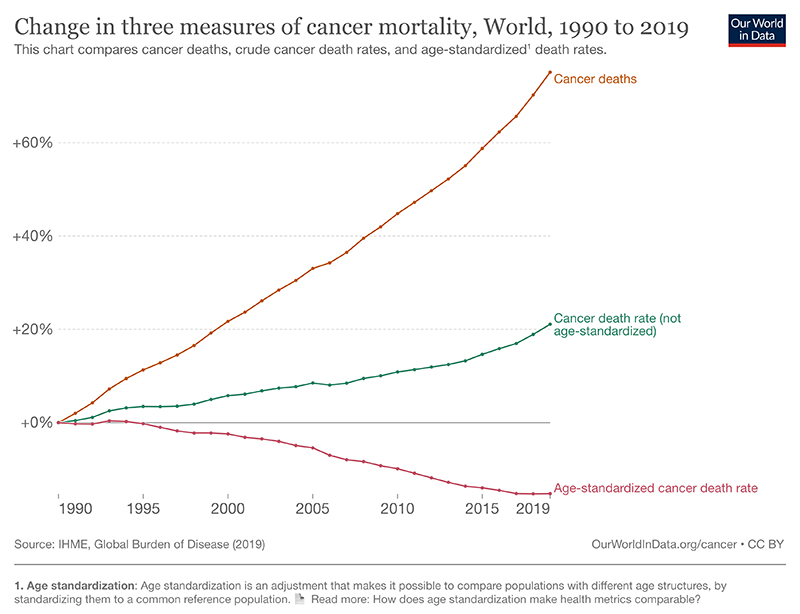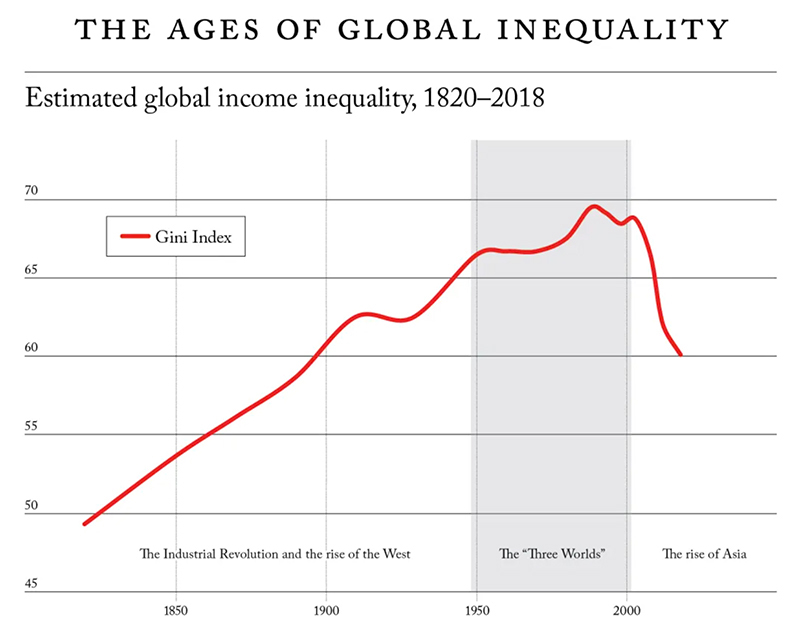Volcanoes are erupting in The Philippines, but on-fire Australia received some welcome rain. The Iran war cries have been called off and The Donald’s military powers are about to be hamstrung by the Senate. Meanwhile, his impeachment trial is starting, and we’re all on Twitter for a front-row seat.
What Could Go Right? Beating cancer
With new tools and better data, we're slowly sending a global scourge into remission.
This is our weekly newsletter, What Could Go Right? Sign up here to receive it in your inbox every Thursday at 6am ET. You can read past issues here.
Beating cancer
Everyone knows someone who has been touched by cancer. It is a leading cause of death worldwide; in 2020, says the World Health Organization (WHO), one in every six deaths was from cancer. While the number of cancer deaths is rising—around 10 million in 2020—this is due to the world’s ever-rising population numbers. Absolute numbers aside, we are actually making strides against cancer, particularly in high-income countries. Globally, the age-standardized death rate from cancer has fallen by 15 percent since 1990, according to Our World in Data. (Since many more old people than young people die of cancer, the age-standardized rate gauges progress by accounting for the world’s growing numbers of older people.)

Among the most common cancers are lung and breast. There has been a spate of positive activity around both in the past couple of weeks, in addition to some possibilities for progress against cervical cancer, which is common in poor countries. Here’s what’s new:
Lung cancer
First, let’s take lung cancer, whose death rates have actually been declining in countries where smoking rates are also declining.
Lung cancer was long considered a death sentence. But now, even lung cancer, caught early, is curable, and in the United States, doctors have begun recommending CT lung screening for high-risk patients, like heavy smokers, now that better data has lowered the risk of false positives.
Lung cancer can also have little to do with smoking, and develop due to a mutation on a gene called EGFR. For these cases, a pill from AstraZeneca, osimertinib, has been shown to halve cancer recurrence rates after tumor-removal surgery. Now, new results show that it also cuts the risk of dying in half post surgery, with 88 percent of patients taking the pill daily still alive after five years.
Since the mutation on the EGFR gene is found in “about a quarter of global lung cancer cases, and accounts for as many as 40 percent of cases in Asia,” per the Guardian, the pill is both another tool in the lung cancer-fighting toolbox and a call to expand EGFR gene mutation testing upon lung cancer diagnosis.
Now should also come the push for access and affordability. The drug costs $17,000 monthly and is available in a limited number of countries.
Breast cancer
Next, breast cancer. Survival rates for breast cancer have improved mightily since the 1990s. A study out of England this month showed that the 14.4 percent risk of death within five years for women diagnosed in the 90s dropped to 4.9 percent for women diagnosed between 2010 and 2015.
There’s also a drug on the scene for breast cancer, ribociclib, which, similar to osimertinib, is proving to be life-saving in new ways. Initially used in cases where the cancer had already spread beyond the breast, recent data show that it cuts the risk of recurrence by 25 percent in early-stage cases as well.
On the early detection front, AI-assisted models are better at assessing risk for breast cancer than the ones currently in standard practice. And on the “can’t be at risk if you can never get it” front, several trials are underway for preventative breast cancer vaccines.
Cervical cancer
Ninety percent of cervical cancer deaths occur in poor countries, where a third of all cancer cases come from the human papillomavirus (HPV) and hepatitis. The HPV vaccine is very effective at preventing cervical cancer, and widespread vaccination could reduce its incidence by as much as 90 percent.
The issue is that it is not widespread at all—only 12 percent of eligible girls were vaccinated in 2021—partly since the vaccine requires two or three doses. In other words, it’s expensive, and it’s difficult to get girls to come back for all three jabs.
Last year, however, the WHO recommended countries move to a single dose of the vaccine, after evidence emerged that one dose works just as well as two or three. So far 24 countries have followed the advice, switching to a one-dose plan; this National Geographic article outlines all the benefits of doing so, including for countries so burdened by the cost of a vaccination plan that involves multiple doses that they haven’t yet even put one into place.
This Economist graph highlights what is possible if HPV vaccination rates can reach 90 percent by 2030, which is the WHO’s goal:

This would avert an estimated 2.65 million deaths from cervical cancer.
One thing that will help that goal along is that China and India are now producing their own HPV vaccine for the first time. “The Serum Institute of India,” reports The Economist, “plans to make 200m doses in two years at prices well below the current market rate. Its output should supply India’s first national vaccination effort.”
Last year President Biden announced his Cancer Moonshot, to cut the death rate from cancer by half over the next 25 years in the US. We can apply such aspirations globally, too. Cancer is a scourge, and the number of people affected by it is likely to go up as long as the population keeps going up. But our tools for preventing, spotting, and combating it are growing, too.
Quick hits
A woman with schizophrenia “awakened” after 20 years when doctors treated her autoimmune disease. Could the approach be applied more broadly?
Global inequality is rising. Wrong! Global inequality is at its lowest level in over a century. See more below.
Below in the links section, space-based solar power, reanimated donor hearts, ocean-based carbon removal, and more.

Renovating Our House with Danielle Allen | S4 E18

Is change possible? Can democracy be renovated to serve the constituency better? And what does this mean for the 2024 election? Political theorist at Harvard University and founder and president of Partners in Democracy, Danielle Allen, joins us to talk about how democracy is (or isn’t) addressing our most urgent concerns. Plus, LGBTQ support skyrockets worldwide and a Supreme Court ruling on gerrymandering. | Listen to the episode
Progress, Please
(Found good news? Tweet at us @progressntwrk or email.)
Other good stuff in the news 🫀
Energy & Environment:
- The US is getting its first new nuclear reactor in 40 years | Grist
- Climate change and the greening of American health care | Politico
- Scientists beam solar power to Earth from space for first time ever | Scientific American
- Scotland’s first electric electric-powered heavy goods vehicle starts making trips | BBC
- In stronghold of Guinea-Bissau, endangered vultures soar again | The Christian Science Monitor
Public Health:
- Reanimated hearts donated after death work just as well for transplants, study finds | Stat News
- ‘A gamechanger’: new meningitis vaccine hailed as major step | The Guardian
- Africa’s largest polio vaccination drive since 2020 targets 21 million children | WHO
- Woodworking and hugs: Inside the mental health movement for men | Reasons to Be Cheerful
Science & Tech:
- A new $50 million project: ocean-based carbon removal | MIT Technology Review
- Delta to unveil foldable seat design that allows flyers to stay in their wheelchairs | Nice News
- Megawatt electrical motor designed by MIT engineers could help electrify aviation | MIT News
- NASA’s newest X-plane wants to save the planet | Vox
- Handheld device could 3D-print tissues and organs in-situ | E&T
- Scientists have developed a super repellent that can stop 99% of mosquitos from biting your skin | Euronews
Politics & Policy:
- Switzerland changes law on sexual violence after arguing over what non-consensual sex is | Nadja News
- North Carolina governor launches safe gun storage campaign as Raleigh recovers from mass shooting | AP
- The Supreme Court just handed down a significant victory for voting rights | Vox
- Australia to triple size of protected marine park to area larger than Germany | CNN
- France will spend €2 billion to double bike lanes, expand cycling | Forbes
- Meet the LGBTQ activist who challenged his Caribbean country’s anti-sodomy law and won | AP
Society & Culture:
- How Chile’s stolen babies are finding their biological families after decades apart | Rest of World
- Global inequality in well‐being has decreased across many dimensions | Cato Institute
- Morality is declining, right? Scientists say that idea is an illusion | Nature
- The number of no-kill animal shelters is at an all-time high | Best Friends
- GOP’s booming support for guns is turning off millennial, Gen Z Republicans | Politico
- Pride 2023: What’s changed since last year? | IPPF
TPN Member originals 🧠
(Who are our Members? Get to know them.)
- Stopping culture wars in their tracks: How one city did it | Courtney Martin
- Tim Scott’s wise words | Matthew Yglesias
- Has China’s power peaked? | Ian Bremmer
- Why AI can’t replace market capitalism | James Pethokoukis
- Race, identity, and democracy | John Wood Jr. & Manu Meel
- The happiest way to change jobs | The Atlantic
- It’s great to have a president who knows when to shut up | Matthew Yglesias
- A plea for solutionism on AI safety | Jason Crawford
- Don’t censor racism out of the past | The Atlantic
- Tomiwa Owolade on what we get wrong about race | Yascha Mounk
- The Trump indictment | Isaac Saul
- Wildfires have partially reversed crucial progress on clean air | Matthew Yglesias
- The orange man is bad | Matthew Yglesias
- The labor-savvy leader | Roy E. Bahat
- Non-member add: Much of America’s political divide is an illusion | Michael Baharaeen
Department of Ideas 💡
(A staff recommendation guaranteed to give your brain some food for thought.)
Thursday | The New Yorker
A new short story by George Saunders
Why we picked it: Defenders of fiction have long pointed out its empathy-generating powers. A unique example of that power at work can be found in this story, in which one man literally shares the feelings of another via, as the story’s editor Deborah Treisman puts it in her interview with Saunders, “a kind of (unwanted) mind meld.” It’s fascinating how “truthful” things like news and politics can often distort reality, whereas “reality-distorting” things like (science) fiction can often guide us to bigger and deeper truths. —Brian Leli
Until Next Time
Peak medicinal gratitude age? Anti-death age? Modern existential renewal year? You decide. 💉👇



[…] note: Our edition two weeks ago on cancer linked to a British study that showed that the risk of death for women diagnosed with breast […]